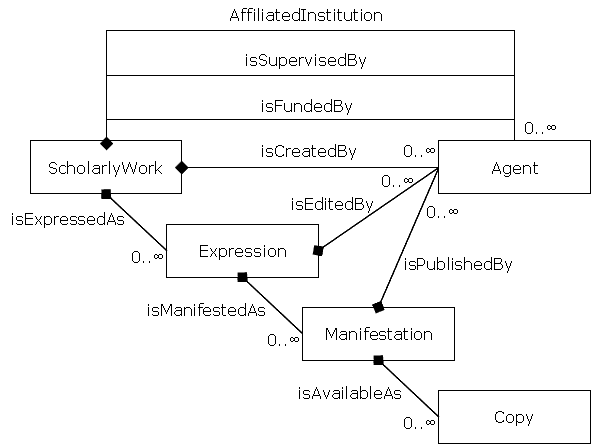Model
From DigiRepWiki
|
[ Home | Functional Requirements | Application Model | Application Profile | Community Acceptance Plan | Mapping to Simple DC | XML Format |
Contents |
Introduction
This document presents a model for eprints based on the Functional Requirements for Bibliographic Records (FRBR).
In the context of this model an eprint is defined to be a scientific or scholarly research text (as defined by the Budapest Open Access Initiative), for example a peer-reviewed journal article, a preprint, a working paper, a thesis, a book chapter, a report, etc.
Readers that are not familiar with FRBR should read A note about FRBR before proceeding.
Eprint Model
Although FRBR is used as the basis of the model, some of the entity and relationship labels used in FRBR have been modified for this model, in order to make them more intuitive to those dealing with eprints:
- a ScholarlyWork is a FRBR Work
- a Copy is a FRBR Item
- an Agent is a FRBR Person or a FRBR Corporate Body
- the isExpressedAs relationship is known as 'is realized through' in FRBR
- the isManifestedAs relationship is known as 'is embodied in' in FRBR
- the isAvailableAs relationship is known as 'is exemplified by' in FRBR
- the isCreatedBy relationship is known as 'is created by' in FRBR
- the isPublishedBy relationship is modelled as the 'publisher' attribute of a Manifestation in FRBR
A ScholarlyWork is a distinct intellectual or artistic scholarly creation.
The isExpressedAs, isManifestedAs and isAvailableAs relationships can be thought of as 'vertical' relations between the ScholarlyWork and its Expressions, between an Expression and its Manifestation and between a Manifestation and its Copies. There are also 'horizontal' relationships between different Expressions of the same ScholarlyWork (e.g. the 'has a translation' relationship in FRBR), different Manifestations of the same Expression (e.g. the 'has an alternative' relationship in FRBR) and so on. These 'horizontal' relationships have not been included in this model. Software applications may be able to infer some of these 'horizontal' relationships by navigating up and down the 'vertical' relationships.
In natural language, what the above model says is:
A ScholarlyWork may be expressed as one or more Expressions. Each Expression may be manifested as one or more Manifestations. Each Manifestation may be made available as one or more Copies. Each ScholarlyWork may have one or more creators, funders and supervisors. Each Expression may be have one or more editors. Each Manifestation may have one or more publishers.
The most common forms of Expression of an eprint are the various 'revisions' that it goes through (draft, pre-print, ..., final published version, etc.) and its different translations. Therefore, the most important Expression to Expression relationships required are isVersionOf/hasVersion and isTranslationOf/hasTranslation.
Attributes
Attributes of a ScholarlyWork
- title
- subject
- abstract
- grant number
- has adaptation
- identifier (URI)
Attributes of an Expression
- title
- description
- date available
- status
- version number or string
- language
- genre / type
- copyright holder
- has version
- has translation
- bibliographic citation
- references
- identifier (URI)
Attributes of a Manifestation
- format
- date modified
- identifier (URI)
Attributes of a Copy
- date available
- access rights
- licence
- is part of
- identifier/locator (URI)
Attributes of an Agent
- name
- family name
- given name
- type of agent
- workplace homepage
- mailbox
- homepage
- identifier (URI)
A note on Open Access
"By 'open access' to this literature we mean its free availability on the public internet, permitting any users to read, download, copy, distribute, print, search, or link to the full texts of these articles, crawl them for indexing, pass them as data to software, or use them for any other lawful purpose, without financial, legal, or technical barriers other than those inseparable from gaining access to the internet itself. The only constraint on reproduction and distribution, and the only role for copyright in this domain, should be to give authors control over the integrity of their work and the right to be properly acknowledged and cited." http://www.earlham.edu/~peters/fos/boaifaq.htm#openaccess
Therefore, open access is a combination of access rights (freely available) and usage rights (able to be used openly).
The CC Attribution licence (http://creativecommons.org/licenses/by/2.5/) is a good example of an 'open access' licence.
These attributes can be captured using the existing DC properties dcterms:accessRights and dcterms:license (note US spelling).
Being made available on an open access basis is a feature of the Copy - i.e. the same Manifestation may be made available as a non-open access Copy (e.g. the publisher copy) and an open access Copy (e.g. the copy in the institutional eprint archive).
A note on implementing this model using Dublin Core metadata
Many of the above relationships and attributes can be implemented fairly easily using metadata terms already defined by the Dublin Core. Note that the DC properties called dcterms:hasVersion and dcterms:hasFormat are defined in a way that implies they are 'horizontal' relationships rather than 'vertical' ones.
DC metadata tends to be thought of as only being capable of describing flat, single-entity, constructs - a Web page, a document, an image, etc. However, the DCMI Abstract Model introduces the notion of a description set, a group of related descriptions, which allows it to be used to capture metadata about more complex sets of entities, using models like the one described here.
DCMI is currently developing a revised set of encoding guidelines for XML and RDF/XML, which will allow these more complex, multi-description, description set constructs to be encoded and shared between software applications.
Readers that are not familiar with the DCMI Abstract Model should read A note about the DCMI Abstract Model.


